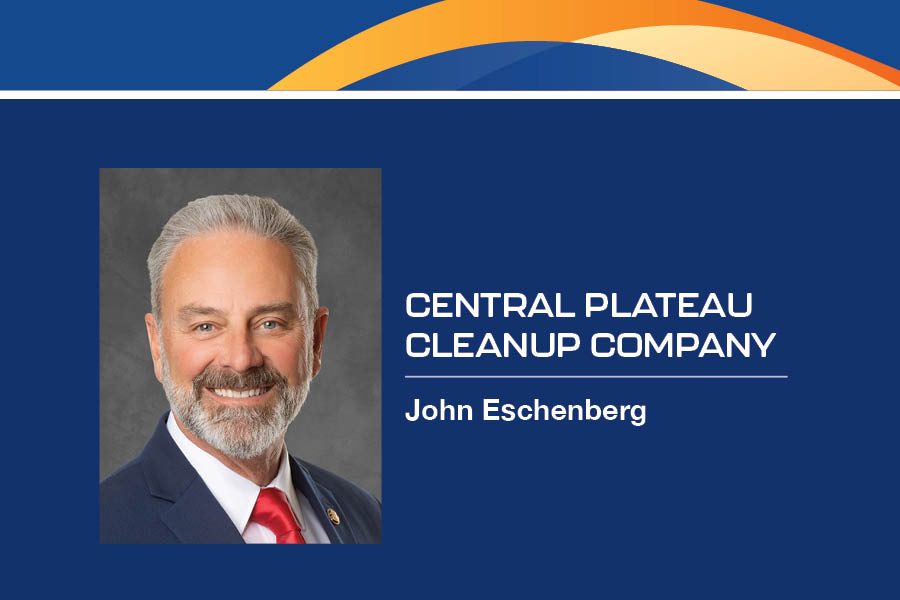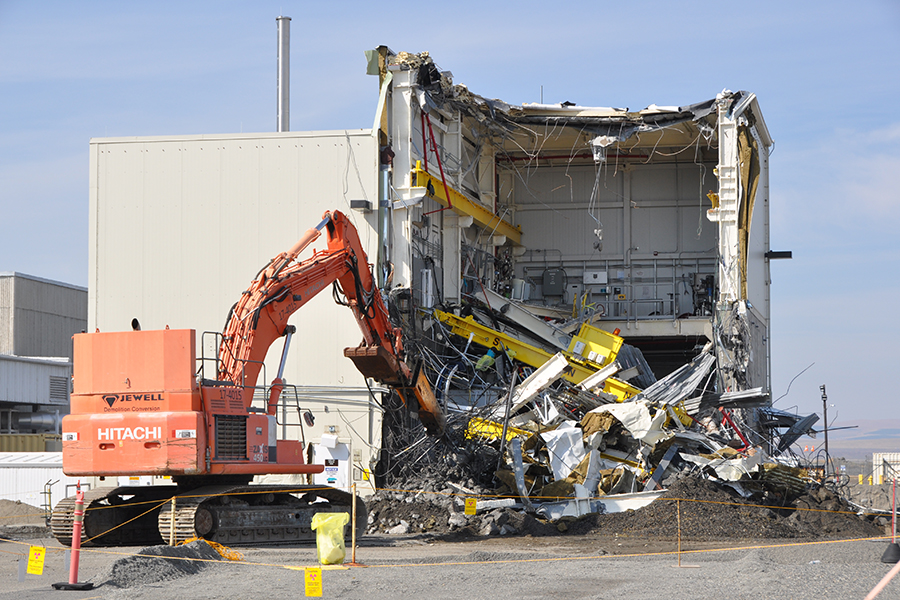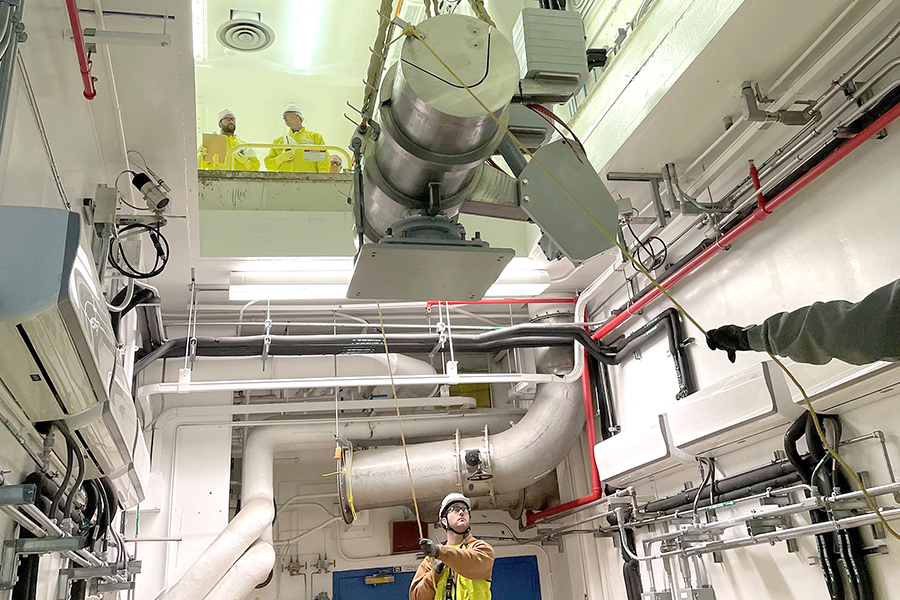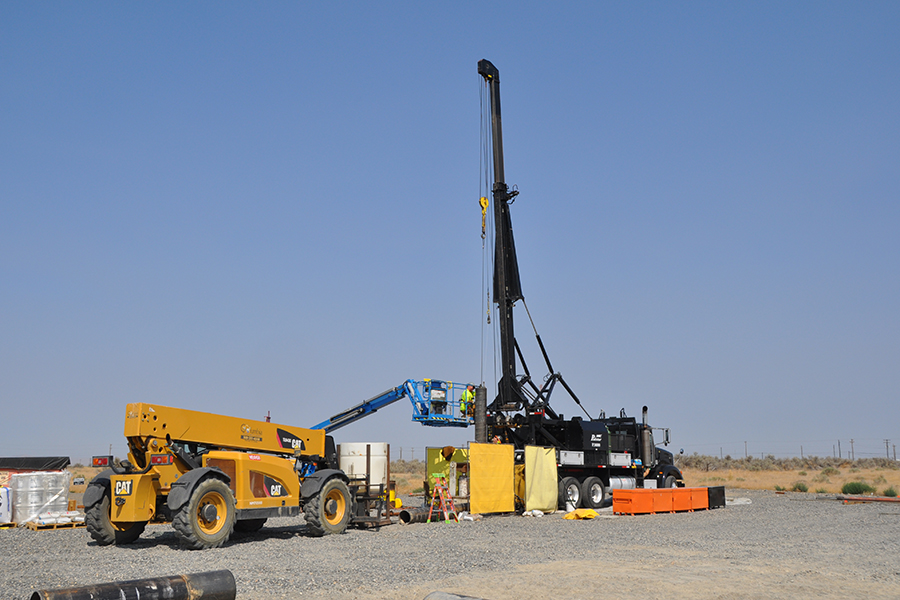
Home » Cleanup is complex task requiring strategic collaboration
Hanford 2024
Cleanup is complex task requiring strategic collaboration

April 15, 2024
By John Eschenberg
It’s hard to believe that Central Plateau Cleanup Company (CPCCo) is just beginning its fourth year leading environmental remediation of the Hanford Site’s Central Plateau and River Corridor. I am immensely proud of our workforce’s accomplishments as we continue to build on the progress of those who came before us.
Last year I mentioned our strategic plan, Vision 2028, and the guiding principles that define our key objectives while delivering safe, efficient and cost-effective solutions to support our U.S. Department of Energy (DOE) customer’s long-term cleanup mission. We made tremendous progress on our end state goals in 2023, and we’re already off to a fast start in 2024.

Demolition of the K West Annex in September 2023 highlights ongoing work to complete cleanup along the Columbia River.
| Courtesy CPCCoPrimary objective
Our primary objective is right in our name: to clean up and reduce risk on the Central Plateau. Located in the heart of the Hanford site, the Central Plateau cleanup footprint covers 75 square miles and contains hundreds of legacy structures and waste sites. Cleanup of this area is a complex task requiring innovation and collaboration among contractors, what we often refer to as our One Hanford initiative.
One of the highest priorities in our One Hanford effort is the Direct-Feed Low-Activity Waste (DFLAW) program to begin vitrifying (or immobilizing in glass) a portion of Hanford’s 56 million gallons of underground tank waste. CPCCo’s role in this monumental effort is management of the Integrated Disposal Facility (IDF), an engineered landfill that will provide permanent, environmentally safe disposal for the containers of treated low-activity tank waste.
With construction recently completed at IDF, the CPCCo team is excited for startup of the tank waste treatment mission and looks forward to the successful transition to operations in 2025.
Another high-priority effort on the Central Plateau is the Waste Encapsulation and Storage Facility (WESF) where nearly 2,000 capsules of radioactive cesium and strontium are stored in an underwater basin. We’ve completed extensive modifications at WESF and are installing a system that will allow workers to package and place the capsules into a safer interim dry storage. This robust storage configuration protects the capsules until a permanent disposal pathway is determined and will significantly reduce surveillance and maintenance costs at the aging WESF facility.

A critical piece of capsule transfer equipment is lifted into the Waste En-capsulation and Storage Facility.
| Courtesy CPCCoOur critical cleanup mission extends beyond the Central Plateau to the River Corridor, the largest cleanup territory on the Hanford site.
In late 2022, we successfully completed a project to place the K East Reactor into interim safe storage in a process called cocooning. The construction project – which required building a massive steel structure over the existing reactor building – was finished ahead of schedule, under budget and with a spotless safety record. This accomplishment did not go unnoticed as our amazing project team was recently recognized with a DOE Secretary’s Achievement Award, the department’s highest form of employee recognition.
With K East cocooning complete, our attention on the River Corridor has been focused squarely on the nearby K West Reactor Area, where crews are preparing to drain the 1.2 million-gallon spent fuel storage basin. The demolition of the Annex building last fall was another key accomplishment at K West. The Annex supported the safe removal of radioactive sludge from the basin. All of this work is reducing risk to the river and moving us closer to cocooning of the K West Reactor, which will be the eighth and final reactor to be cocooned.
Managing B Reactor
Also in the River Corridor is B Reactor, the world’s first full-scale plutonium production reactor, which is preserved as part of the Manhattan Project National Historical Park. This unique park is jointly managed by DOE and the National Park Service. CPCCo proudly manages B Reactor for DOE. Visitors from all 50 states and about 90 countries worldwide have traveled to Hanford to tour the B Reactor. You can check tour availability at manhattanprojectbreactor.hanford.gov.
Another priority for CPCCo is cleaning up contaminated groundwater. Our six pump-and-treat facilities operate 24/7 to remove chemical and radioactive particles from the groundwater, reducing risk across the site and protecting the nearby Columbia River. The pump-and-treat facilities collectively treat more than 2 billion gallons of contaminated groundwater annually, removing 700 tons of contaminants from the aquifer since the program’s inception in the 1990s.
Hanford’s largest groundwater treatment facility – the 200 West Pump & Treat – alone treats more than 1 billion gallons annually, and work is well underway to expand the capacity of this facility from 2,500 to 3,400 gallons per minute. The increased capacity will allow us to treat as much as 650 million additional gallons of groundwater each year, potentially shortening the time needed to meet cleanup goals and reduce costs.
While we’re fiercely committed to our Hanford cleanup mission, we are more than just a cleanup contractor. We are a team of dedicated professionals who care deeply about the future of the Tri-Cities community. To that end, we strive to leave a positive legacy for generations to come by being environmentally responsible, strategically collaborative and socially engaged.

CPCCo is installing about a dozen new extraction wells on the Central Plateau as part of a project to expand treatment capacity at the 200 West Pump & Treat Facility, the largest of Hanford’s six groundwater treatment plants.
| Courtesy CPCCoA clean energy future
At our core, CPCCo is an environmental remediation company, and we’ve pledged to reduce our environmental impact as we carry out our cleanup mission. We have set ambitious goals to reduce our energy consumption and improve efficiency. We’re active partners of the Energy Forward Alliance, a coalition of community leaders committed to driving a reliable and sustainable clean energy future for the Tri-Cities region and beyond.
Our critical work also cannot be completed without the support of small businesses. Our strong partnerships with local companies create jobs and support economic development. Since 2021, CPCCo has awarded more than $182 million to 150 small businesses in the Tri-Cities region.
Just like we invest in small business, CPCCo also invests in the next generation of nuclear workers. We have a thriving summer internship and cooperative education program thanks to our long-standing partnerships with Washington State University and Columbia Basin College. This not only establishes a pipeline of high-caliber local candidates for potential future employment, but also energizes the workforce with fresh perspectives and new ideas.
At CPCCo, we’re building on our past achievements for future success in 2024 and beyond.
To learn more about recent successes, view our 2023 Annual Report at bit.ly/CPCCO2023report.
John Eschenberg is president of Central Plateau Cleanup Company.
Latest News Hanford
KEYWORDS April 2024
Related Articles





